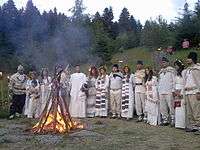Zalmoxianism
Zalmoxianism or Zamolxianism[1] is a Neopagan movement in Romania which promotes the rebuilding of an ethnic religion and spirituality of the Romanians through a process of reconnection to their ancient Dacian and Thracian roots.[2] The religion takes its name from Zalmoxis or Zamolxe, at the same time the name of the primordial god and the archetype of the enlightened man in Paleo-Balkan mythology. Scholars Bakó and Hubbes (2011) have defined Zalmoxianism, like the other ethnic religious revivals of Europe, as a reconstructionist ethno-paganism.[3]
Origins
The reconstruction of ancient Dacian and Thracian religion and mythology has been strictly connected with the field of dacology.[4] Amongst contemporary supporters of Zalmoxianism, the emigrant dacologist Octavian Sărbătoare even proposed to make it the official religion of Romania.[5]
Organisations
Gebeleizis Association
The "Gebeleizis Association" (Romanian: Societatea Gebeleizis), though far from being the only Zalmoxian group in Romania, has been the most studied formation.[6] It has 500 members split into 15 branches.[7] The core values of the organisation are expressed by its motto "One Family, One Nation, One Territory" (Romanian: O Familie, Un Neam, Un Teritoriu);[8] for the ideas promoted, the Gebeleizis Association has been subject of media scandal, and accused of extremism.[9] "Gebeleizis" was the same as Zalmoxis among the Thracians.
Zamolxe group
Another group is the Zamolxe, based in Bucharest, whose high priest is Alexandru Mihail. They worship the old Thraco-Dacian pantheon of gods, and claim that the name "Zalmoxis" comes from zamol, meaning "earth".[10]
-
Symbol of Zamolxiana New Religious Movement.
-

Dacian Sacred Fire ceremony at Detunata temple during 2013 in Romania.
-

The Dacian Sacred Fire at Costesti, Romania, in 2012.
See also
References
Bibliography
- László-Attila Hubbes. Romanian Ethno-Paganism: Discourses of Nationalistic Religion in Virtual Space. In Native Faith and Neo-Pagan Movements in Central and Eastern Europe. Kaarina Aitamurto, Scott Simpson. Acumen Publishing, 2013. ISBN 1844656624
- Rozália Klára Bakó, László-Attila Hubbes. Religious Minorities' Web Rhetoric: Romanian and Hungarian Ethno-Pagan Organizations. Journal for the Study of Religions and Ideologies, vol. 10, issue 30, Winter 2011: 127-158. ISSN 1583-0039
External links
- Societatea Gebeleizis ("Gebeleizis Association")
- Spiritualitate Daco-Românească ("Daco-Romanian Spirituality")
- Octavian Sarbatoare. The Foundations of Zamolxiana New Religious Movement, 2014. ISBN 9780992446819